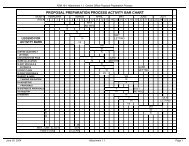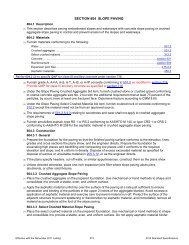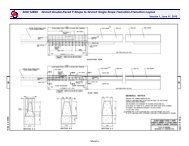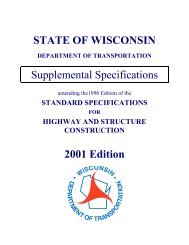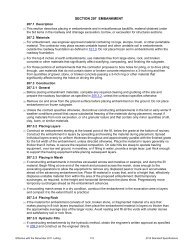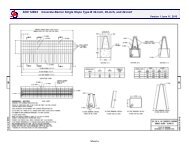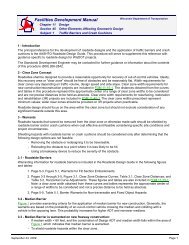12 Spec - Section 518 Mortar Rubble Masonry and Dry Rubble ...
12 Spec - Section 518 Mortar Rubble Masonry and Dry Rubble ...
12 Spec - Section 518 Mortar Rubble Masonry and Dry Rubble ...
Create successful ePaper yourself
Turn your PDF publications into a flip-book with our unique Google optimized e-Paper software.
<strong>518</strong>.3 Construction<br />
<strong>518</strong>.3.1 Shaping <strong>and</strong> Dressing Stone<br />
(1) Roughly square the stones on joints, beds, <strong>and</strong> faces. Use stone, roughly squared <strong>and</strong> pitched to line, at<br />
all angles <strong>and</strong> ends of walls. Finish all corners or angles in exterior surfaces with a chisel draft. If placing<br />
a wall stone with a sawed exterior surface, dress it a minimum of 50 percent before placing in the wall.<br />
(2) Perform all stone shaping or dressing before laying the stone in the wall <strong>and</strong> do not allow any dressing or<br />
hammering that might loosen the stone after placement.<br />
<strong>518</strong>.3.2 Laying Stone<br />
<strong>518</strong>.3.2.1 <strong>Mortar</strong> <strong>Rubble</strong> <strong>Masonry</strong><br />
(1) The contractor shall not construct stone masonry in freezing weather, or if the stone contains frost, except<br />
with the engineer’s written permission <strong>and</strong> subject to any conditions required.<br />
(2) Clean each stone surface until free of foreign matter, loose rock grains, <strong>and</strong> rock dust, then saturate with<br />
water before setting. Ensure the bed receiving the stone is clean <strong>and</strong> well moistened. Well bed all stones<br />
in freshly made mortar. Lay the masonry to line in courses roughly leveled up. For the bottom or<br />
foundation, courses use large, selected stones <strong>and</strong> lay all courses with bearing beds parallel to the<br />
natural bed of the material.<br />
(3) Ensure the vertical joints in each course are staggered with those in adjoining courses by at least 6<br />
inches. The contractor shall not locate a vertical joint directly above or below a header.<br />
(4) Make full mortar joints <strong>and</strong> carefully settle the stones in place before the mortar sets. The engineer will<br />
not accept spalls in the beds. Provide joints <strong>and</strong> beds no more than one inch thick.<br />
(5) Always try to properly point the face joints before the mortar sets. If this is not possible, prepare the joints<br />
for pointing by raking them out to a depth of 2 inches before the mortar sets. Take care not to smear the<br />
stone face surfaces with the mortar forced out of the joints, or that used in pointing.<br />
(6) If any stone is moved or the joint broken, take up the stone, thoroughly clean the mortar from the bed <strong>and</strong><br />
joints, <strong>and</strong> reset the stone in fresh mortar.<br />
<strong>518</strong>.3.2.2 <strong>Dry</strong> <strong>Rubble</strong> <strong>Masonry</strong><br />
(1) Lay the masonry to line <strong>and</strong> in courses roughly leveled up. For the bottom or foundation courses use<br />
large, selected stones <strong>and</strong> lay all courses with bearing beds parallel to the natural bed of the material.<br />
Use s<strong>and</strong> for the initial bedding. Face joints shall not exceed one inch in width.<br />
(2) If laying dry rubble masonry, take care that each stone bears firmly on the underlying course at not less<br />
than 3 separate points. Chink open joints, both front <strong>and</strong> rear, with spalls fitted to take firm bearing upon<br />
their top <strong>and</strong> bottom surfaces, to secure firm bearing throughout the stone length.<br />
<strong>518</strong>.3.3 Pointing <strong>Mortar</strong> <strong>Rubble</strong> <strong>Masonry</strong><br />
(1) The contractor shall not perform pointing in freezing weather or if the stone contains frost.<br />
(2) For joints not pointed when laying the stone, thoroughly wet the joint with clean water <strong>and</strong> fill with mortar,<br />
drive the mortar soundly into the joints <strong>and</strong> finish with an engineer-approved pointing tool. Keep the wall<br />
wet while pointing, <strong>and</strong> in hot or dry weather protect the pointed masonry from the sun <strong>and</strong> keep wet for<br />
at least 3 days after completion.<br />
(3) After completing the pointing <strong>and</strong> the mortar sets, clean the wall <strong>and</strong> leave it in a neat, finished condition.<br />
<strong>518</strong>.3.4 Backfill<br />
(1) Backfill shall conform to 206.3.13.<br />
<strong>518</strong>.4 Measurement<br />
(1) The department will measure <strong>Rubble</strong> <strong>Masonry</strong> <strong>Mortar</strong> <strong>and</strong> <strong>Rubble</strong> <strong>Masonry</strong> <strong>Dry</strong> by the cubic yard<br />
acceptably completed.<br />
<strong>518</strong>.5 Payment<br />
(1) The department will pay for measured quantities at the contract unit price under the following bid items:<br />
ITEM NUMBER DESCRIPTION UNIT<br />
<strong>518</strong>.0100 <strong>Rubble</strong> <strong>Masonry</strong> <strong>Mortar</strong> CY<br />
<strong>518</strong>.0200 <strong>Rubble</strong> <strong>Masonry</strong> <strong>Dry</strong> CY<br />
Effective with the December 2011 Letting 341 20<strong>12</strong> St<strong>and</strong>ard <strong>Spec</strong>ifications








